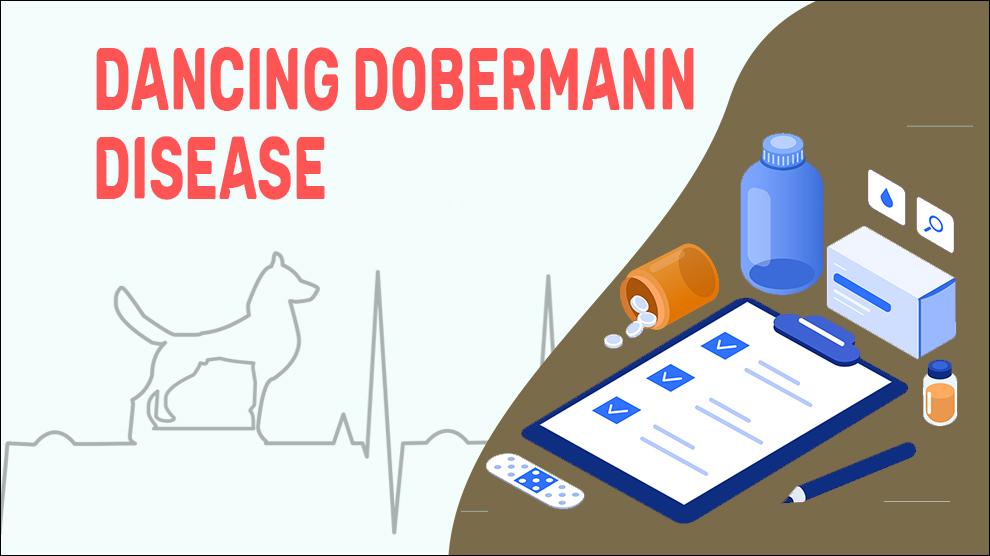Dancing Doberman disease (DDD) -Spasm of the hind legs in dogs. This is a genetic neurological disorder mostly seen in Dobermans. Also called distal polyneuropathy, this is a type of myopathy that causes the dog’s lower hind legs (gastrocnemius muscle) to flex spontaneously, making the dog look like dancing.
The cause of the disease is still mysterious, but as of now, it is known that the calf muscles are affected due to peripheral sensory neuromyopathy. There are no reports of this condition in other breeds. This affects only Dobermans and Miniature Dobermans are also no exception
Dancing Doberman disease symptoms are similar to many other disorders such as wobbler syndrome, spinal tumors, inflammation of the spinal cord, spinal arthritis, cauda equina syndrome, and cervical vertebral instability (CVI), lumbosacral disc disease, neuropathy, myasthenia gravis, and hip dysplasia.
However, the major distinguishing factor is that dogs with DDDs seem to have no pain in any way. Some vet neurologists refute this stating that there may be a burning feeling in the pet’s leg that causes him to hop and shift the foot. While the disease does not seem to be painful, it is progressive and there is no proper treatment.
Symptoms Of Dancing Dobermann Disease
- Flexing hind leg and hip muscles
- Unwillingness to walk, reluctant to climb stairs, play or jump
- Lameness/ abnormal gait
- Shuffling and scuffing toes
- Trailing behind on walks
- Stiffness or soreness when getting up or down
- Incontinence /Trouble urinating or defecating
- Rear paws dragging
Treatment Options For Dancing Dobermann Disease
There is no proper treatment for DDD
Physical therapy, pain medication, bone supplements, and making sure the affected dogs do not become overweight can be done.
1. DDD is not associated with pain. But if there are any pain NSAIDs may be prescribed:
- Metacam (meloxicam)
- Deramaxx (deracoxib)
- Rimadyl (carprofen)
- Previcox (firocoxib)
- EtoGesic (etodolac)
2. If there is any swelling and inflammation in joints, Prednisone, dexamethasone, and other corticosteroids will be prescribed for a short duration.
Home Remedies For Dancing Dobermann Disease
- Start a Nutritionally Sound Diet Early.
- Exercise Your Dog the Right Way.
- Regular visits to the vet including yearly once comprehensive examination.
- Ask Your Veterinarian about bone and Joint Supplements.
- Maintain your dog’s optimal weight.
Prevention Of Dancing Dobermann Disease
DDD has been linked to inherited genetic defects although the exact gene is not yet confirmed. Therefore, the best method of prevention is responsible breeding practices.
Breeders should keep track of lineages with a lower-grade form of this disease and stop breeding the dogs.
Affected Breeds Of Dancing Dobermann Disease
Additional Facts For Dancing Dobermann Disease
1. Causes:
Hereditary
2. Mortality:
Most of the cases have a normal life span even in moderately severe cases; most dogs can continue to live comfortably with treatment. The life expectancy of DDD dogs is normal except in rare cases.
3. Diagnosis:
- X-rays of a dog's hindquarters
- Muscle biopsies
- MRI or CT scans to rule out a tumor
- Electromyography
- ACh receptor autoantibody test
- Myelograms
4. Prognosis:
DDD can be very mild to severe. The outcome is typically good as the quality of life of dogs is not affected.
Your vet will periodically re-examine the pet on a regular basis to check for improvements. Check if the breed is predisposed to any other genetic issues such as hip dysplasia in dogs. Healthy history is important as if there has been an accident with your dog or ligament injuries may contribute to DDD in your dog.
When To See A Vet
Time to visit the vet clinic for an examination, if you notice any of the following:
- Flexing hind leg and hip muscles
- Unwillingness to walk, reluctant to climb stairs, play or jump
Food Suggestions For Dancing Dobermann Disease
Foods to avoid:
- Avoid fatty foods or high in fiber.
- Cutback on greasy, oily, spicy foods.
- Avoid crunchy or chewy snack foods.
- Avoid dairy products likemilk, yogurt, etc.
- Bread products androasted nuts.
- Avoid tougher meats.
What to feed:
- Smaller, more frequent meals of high-quality, high-calorie food.
- Choose softer foods such as mashed, soft, or pureed foods.
- Moisten/soften foods with chicken broth, gravy, or butter.
- Finely chop up veggies, chicken, or meat.
- Watch the salt intake of dogs such as from canned soups or frozen meals.
- Add calcium-rich foods and supplements such as like broccoli, salmon, Sardines, and Dark leafy greens.
Conclusion
Although DDD is not treatable, Pet owners should remember that it is a progressive condition and we can try to slow the progression. The pet’s quality of life is not affected because the pet should still be able to run and walk normally; the only thing is it cannot stand for a longer duration.
In most cases, the veterinarian recommends physiotherapy to restore range of motion and strengthen the bones and muscles.

















